Commerce Exam > Commerce Notes > Economics Class 11 > Short Notes: Theory of Consumer Behaviour
Short Notes: Theory of Consumer Behaviour | Economics Class 11 - Commerce PDF Download
What is Demand?
- Demand refers to the quantity of a commodity a consumer is willing and able to buy at a given price, considering personal tastes and preferences, with other factors constant.
- Changes in the commodity’s price directly affect the quantity demanded: higher prices reduce demand, lower prices increase it.
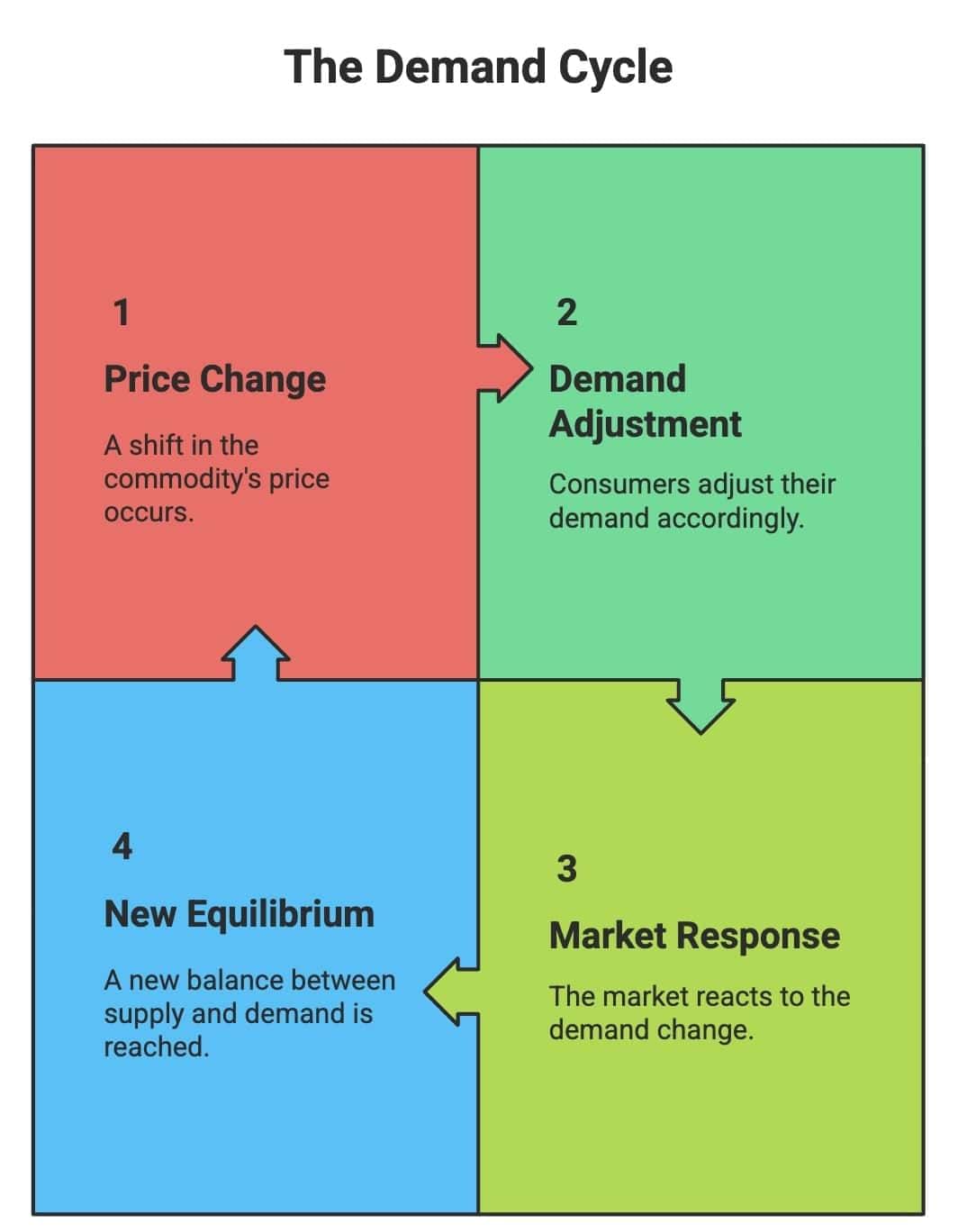
Demand Curve and Law of Demand
- Demand Function: Mathematical representation of the relationship between quantity demanded (X) and price (P), denoted as X = f(P), assuming other factors (e.g., income, preferences) are constant.
- Demand Curve: Graphical representation of the demand function, with price on the vertical axis and quantity on the horizontal axis.
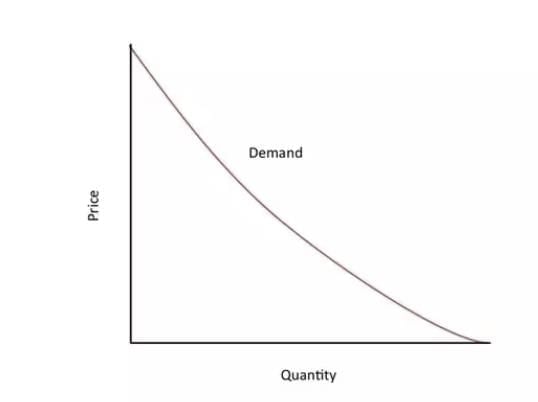
- Law of Demand: States an inverse relationship between price and quantity demanded; as price increases, quantity demanded decreases, and vice versa, all else equal.
- The demand curve slopes downward due to this inverse relationship.
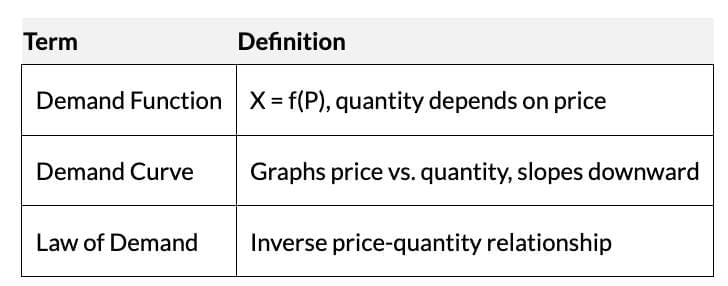
Other Factors Affecting Demand
- Besides price, demand is influenced by:
- Prices of related goods: Substitutes (e.g., tea/coffee) and complements (e.g., tea/sugar).
- Consumer income: Affects purchasing power.
- Tastes and preferences: Shifts demand based on consumer favorability.
Let's understand the effect of these factors on the demand curve:
- Substitutes: If a substitute’s price rises, demand for the original good increases (rightward shift); if it falls, demand decreases (leftward shift).
- Complements: If a complement’s price rises, demand for the original good decreases (leftward shift); if it falls, demand increases (rightward shift).
- Preferences: Favourable changes shift demand right; unfavourable changes shift left.
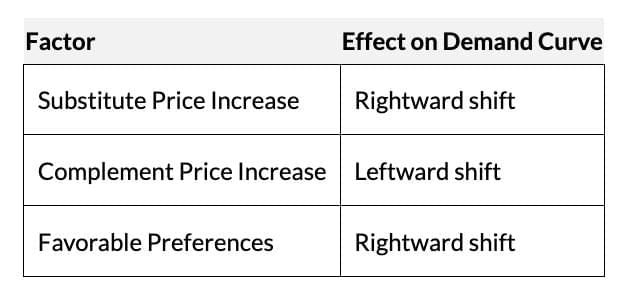
Functions and Demand
- Function: A relationship where each value of the independent variable (x) has a unique dependent variable (y), denoted y = f(x).
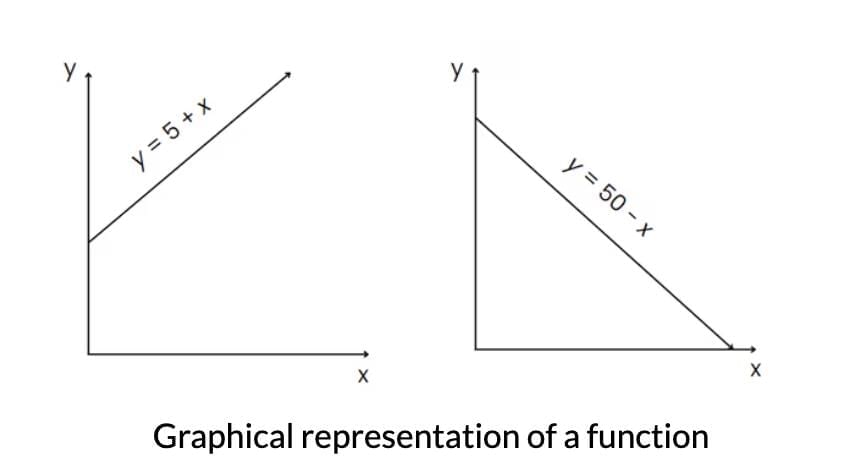
- In demand: Quantity demanded (X) is a function of price (P), X = f(P).
- Increasing Function: y increases as x increases (e.g., y = 5 + x).
- Decreasing Function: y decreases as x increases (e.g., y = 50 - x), like the demand function.
- Graphical Representation: Demand curve is downward sloping, reflecting the negative relationship between price (vertical axis) and quantity (horizontal axis).
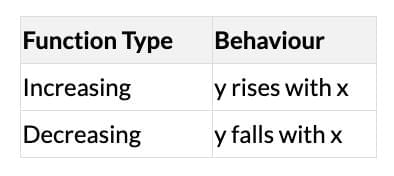
Deriving a Demand Curve
Derived from indifference curves and budget constraints, e.g., for bananas and mangoes with income M and prices P1 (bananas) and P2 (mangoes).
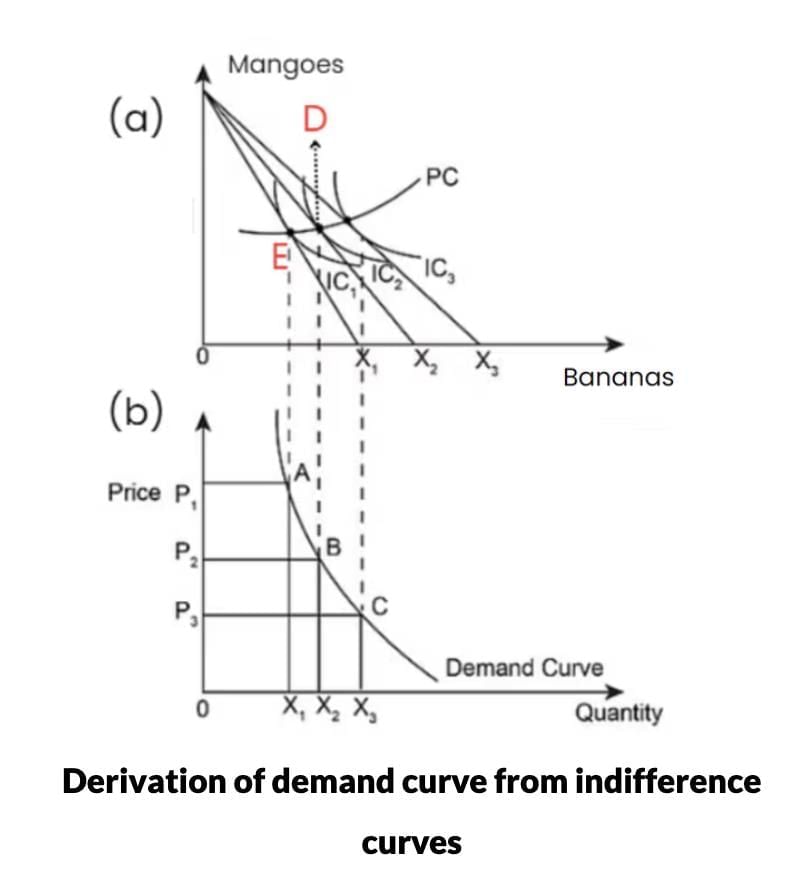
- Initial equilibrium at price P1 yields quantity X1 (bananas).
- Price drop to P2 expands budget, increasing banana consumption to X2.
- Further drop to P3 increases consumption to X3.
- Plotting P1/X1, P2/X2, P3/X3 forms the demand curve.
- Substitution Effect: Lower price makes bananas cheaper relative to mangoes, increasing banana demand.
- Income Effect: Price drop increases purchasing power, boosting demand for bananas.

Linear Demand
Expressed as: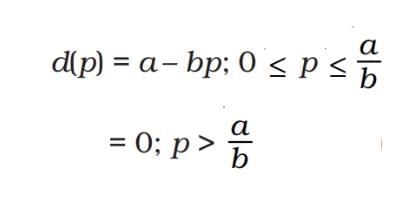 where:
where:- a = intercept (demand at price 0).
- -b = slope (change in demand per unit price increase).
If price rises by 1 unit, demand falls by b units; at price a/b, demand is 0.
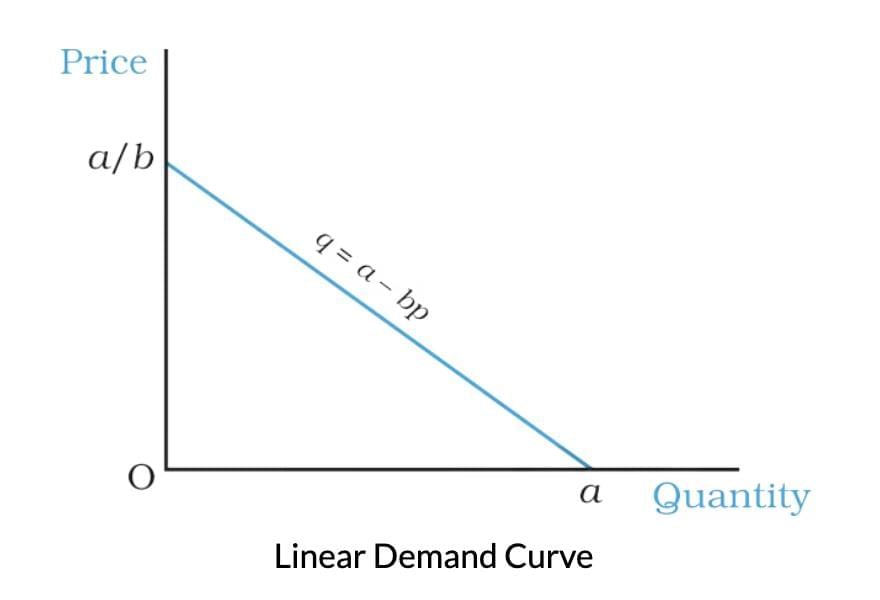
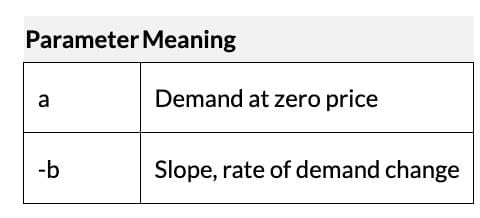
Normal and Inferior Goods
- Normal Goods: Demand increases with income and decreases with income reduction (e.g., most goods).
- Inferior Goods: Demand decreases with income increase and increases with income reduction (e.g., low-quality cereals).
- Giffen Goods: Rare inferior goods where demand rises with price due to a dominant income effect (e.g., staple foods during price hikes), violating the Law of Demand.
- For inferior/Giffen goods, substitution and income effects oppose each other, determining demand direction.
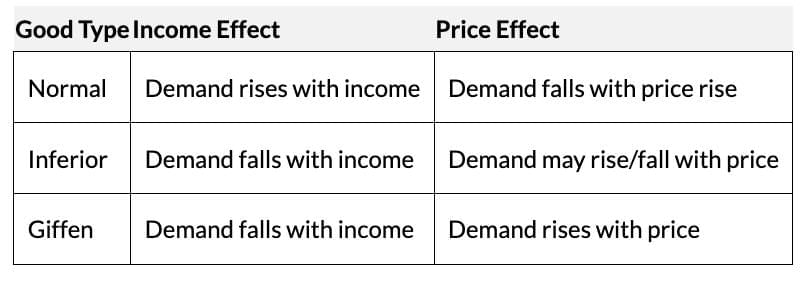
Substitutes and Complements
- Complementary Goods: Consumed together (e.g., tea/sugar); price increase in one reduces demand for the other.
- Substitute Goods: Replace each other (e.g., tea/coffee); price increase in one increases demand for the other.

Shifts in the Demand Curve
- Movements Along the Curve: Caused by price changes of the good, reflecting the Law of Demand.
- Shifts of the Curve: Caused by changes in non-price factors:
- Income: Normal goods shift right with income increase; inferior goods shift left.
- Related Goods: Substitute price increase shifts demand right; complement price increase shifts left.
- Preferences: Favourable changes shift right; unfavourable changes shift left.
- Example: Higher Coca-Cola prices shift Pepsi’s demand curve right; higher milk prices shift cereal’s demand curve left.

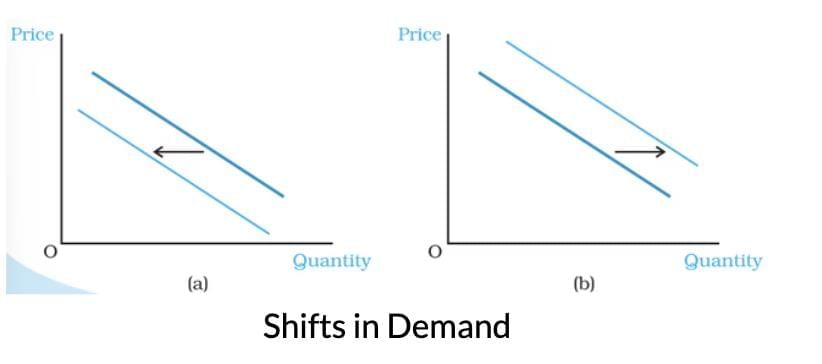
Market Demand
- Definition: Total demand for a good at a specific price from all consumers in the market.
- Derivation: Sum of individual demand curves (horizontal summation).
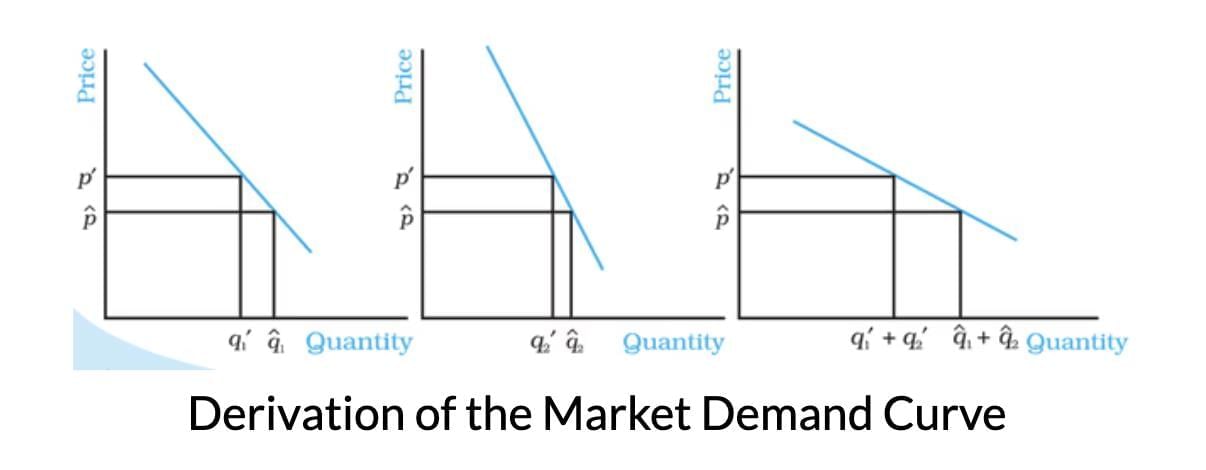
- Example: For two consumers with demands q1’ and q2’ at price p’, market demand is q1’ + q2’.
- Linear Demand Example: Individual demands d1(p) = 10 - p and d2(p) = 15 - p yield market demand:
25 - 2p for p ≤ 10.
15 - p for 10 < p ≤ 15.
0 for p > 15.
The document Short Notes: Theory of Consumer Behaviour | Economics Class 11 - Commerce is a part of the Commerce Course Economics Class 11.
All you need of Commerce at this link: Commerce
|
59 videos|222 docs|43 tests
|
FAQs on Short Notes: Theory of Consumer Behaviour - Economics Class 11 - Commerce
| 1. What is demand in economic terms? |  |
Ans.Demand refers to the quantity of a good or service that consumers are willing and able to purchase at various prices over a specified period of time. It reflects consumer preferences and purchasing power, indicating how much of a product is desired in the market.
| 2. What is the law of demand and what does the demand curve illustrate? |  |
Ans.The law of demand states that, all else being equal, as the price of a good decreases, the quantity demanded increases, and vice versa. The demand curve is a graphical representation of this relationship, typically sloping downward from left to right, indicating that lower prices lead to higher quantities demanded.
| 3. How do substitutes and complements affect demand? |  |
Ans.Substitutes are goods that can replace each other; when the price of one substitute rises, the demand for the other increases. Complements are goods that are consumed together; when the price of one complement rises, the demand for the other decreases. Both types of goods significantly influence consumer choices and overall market demand.
| 4. What are normal and inferior goods, and how do they affect demand? |  |
Ans.Normal goods are those for which demand increases as consumer incomes rise, while inferior goods see an increase in demand when incomes fall. This relationship affects how changes in income levels impact overall demand for different products in the market.
| 5. What causes shifts in the demand curve? |  |
Ans.Shifts in the demand curve can occur due to various factors, including changes in consumer income, preferences, prices of related goods (substitutes and complements), expectations of future prices, and demographic changes. These shifts indicate a change in the quantity demanded at every price level, rather than just a movement along the curve.
Related Searches





















